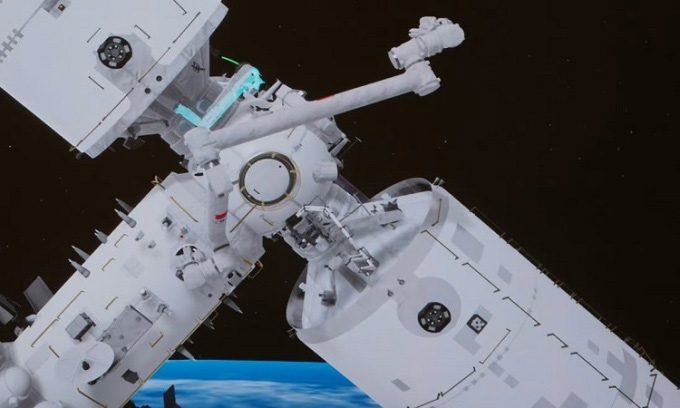The Tiangong station will participate in a project to collect solar energy in space and transmit it back to Earth in the form of high-energy microwave beams.
Tiangong, China’s space station, became fully operational when the final service module named Meng Tian docked at the beginning of November. In a seminar on November 22 in Wenchang, Hainan, Yang Hong, the station’s chief designer, stated that the Tiangong station will play a crucial role in the Space Solar Power Station (SSPS) project of China. The station will provide a testing platform for high-voltage electrical equipment and assist in the assembly of ultra-large structures. According to Yang, the space station has the resources and capabilities to test and validate key technologies, promote technological breakthroughs, and collect experimental data in orbit for the SSPS project.

The Tiangong station will become a testing platform for solar energy transmission technology from space. (Photo: Xinhua).
An article published by the project team in the journal Chinese Space Science and Technology in June described China’s large-scale space solar power plant as a structure one kilometer wide, transmitting gigawatt-scale microwave energy back to Earth from a distance of 36,000 kilometers. Unlike conventional solar farms that only operate during the day, solar panels in space will collect and transmit energy 24 hours a day. The microwave beam can penetrate clouds and be received by ground antennas to generate electricity.
Operating in geostationary orbit, the space plant can direct the microwave beam to almost any location, making it an ideal option for supplying electricity to military equipment or remote bases. Yang shared that the Tiangong space station will participate in several critical experiments to turn the space power plant into reality. Several external ports of the station are designed to connect high-power electrical devices. However, generating strong electrical currents and converting them into microwaves will produce a significant amount of heat and several other complex problems in the space environment.
The Tiangong station is an ideal platform for China to evaluate the long-term performance of new technologies and equipment in orbit. Chinese scientists also plan to use cargo ships (which typically burn up in the atmosphere after missions) as fundamental components to build the space power plant. Using several robotic arms, the Tiangong station can combine multiple cargo ships and some solar panel blocks to create a prototype power plant.
After being raised to an orbit 100 kilometers above the Tiangong station using ion propulsion engines for safety, this small power plant will conduct experiments to validate the technologies for the large-scale plant, including microwave energy transmission and using high-energy laser beams to power a satellite.
China plans to conduct its first energy transmission from space to Earth within the next few years. The small power plant, capable of providing electricity to remote military bases, is expected to be operational by the 2030s, with commercial electricity production anticipated to begin in the 2050s.
In addition to China, the U.S. Air Force also plans to launch a satellite in 2025 that could produce and transmit focused microwave beams from low Earth orbit. Some studies indicate that microwaves operate primarily at the same frequency as wireless routers, which will be safe for humans unless someone enters the receiving area. However, targeting the energy beam at precise locations on Earth across tens of thousands of kilometers remains a significant challenge. Some researchers also warn that continuously transmitting strong energy between space and Earth could disrupt the ionosphere, leading to unexpected effects on the Earth’s environment.




















































